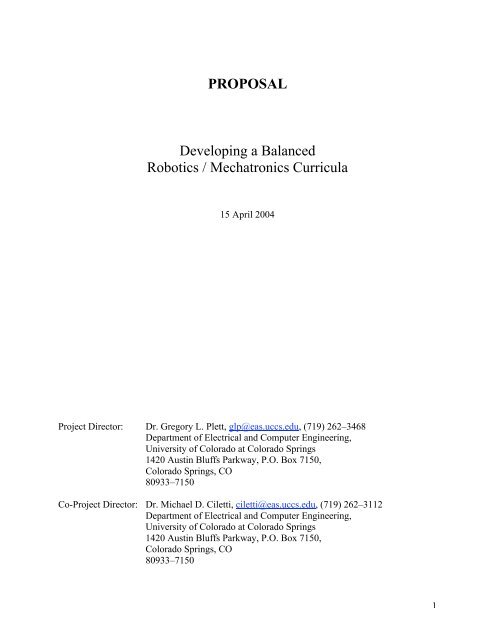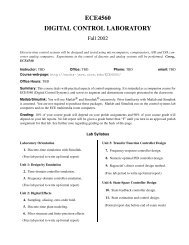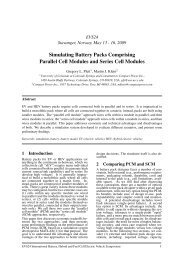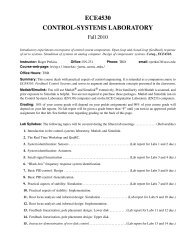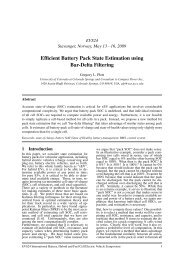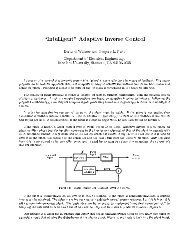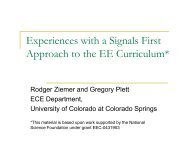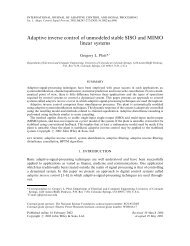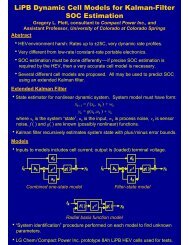PROPOSAL Developing a Balanced Robotics / Mechatronics Curricula
PROPOSAL Developing a Balanced Robotics / Mechatronics Curricula
PROPOSAL Developing a Balanced Robotics / Mechatronics Curricula
Create successful ePaper yourself
Turn your PDF publications into a flip-book with our unique Google optimized e-Paper software.
<strong>PROPOSAL</strong><br />
<strong>Developing</strong> a <strong>Balanced</strong><br />
<strong>Robotics</strong> / <strong>Mechatronics</strong> <strong>Curricula</strong><br />
15 April 2004<br />
Project Director: Dr. Gregory L. Plett, glp@eas.uccs.edu, (719) 262–3468<br />
Department of Electrical and Computer Engineering,<br />
University of Colorado at Colorado Springs<br />
1420 Austin Bluffs Parkway, P.O. Box 7150,<br />
Colorado Springs, CO<br />
80933–7150<br />
Co-Project Director: Dr. Michael D. Ciletti, ciletti@eas.uccs.edu, (719) 262–3112<br />
Department of Electrical and Computer Engineering,<br />
University of Colorado at Colorado Springs<br />
1420 Austin Bluffs Parkway, P.O. Box 7150,<br />
Colorado Springs, CO<br />
80933–7150<br />
1
Project Summary<br />
This proposal requests funding for a project to develop a balanced, hands-on curriculum in robotics/mechatronics<br />
in the Department of Electrical and Computer Engineering at the University<br />
of Colorado at Colorado Springs to broaden career opportunities for students by preparing them<br />
for Colorado's technology workforce of the future. Project funds will purchase advanced robot<br />
kits and develop two new courses (senior and graduate level) to leverage existing resources and<br />
build on the success of the department's new first-year course in robotics.<br />
The project will exploit recent results in modern learning theory (i.e., the so-called Kolb-<br />
4MAT learning cycle) to balance the curriculum in robotics so that it addresses the spectrum of<br />
learning modalities, and incorporates hands-on experiential learning in its pedagogy. Using university<br />
funds, the project team has already developed and successfully implemented a first-year<br />
course in robotics. The proposed courses will build on that success to provide an opportunity for<br />
students to take senior- and graduate level courses in conjunction with the existing degree programs<br />
in electrical, computer, and mechanical engineering, and to participate in internships with<br />
industry.<br />
Results of the proposed robotics thrust at UCCS will be shared with other engineering programs<br />
in the state to foster cooperation, collaboration of new projects for students, and joint research<br />
efforts.<br />
2
1. Project Description<br />
The goal of this project is to establish a curriculum in robotics that will benefit the students and<br />
industry of Colorado. Our premises are:<br />
1 Since technology is vital to Colorado's economy and since it impacts our daily life, it is<br />
important for students of all disciplines—and especially those in engineering programs—to<br />
have a solid fundamental understanding of the complex choices underlying the<br />
design, construction, and operation of technology-based systems.<br />
1 A curriculum in robotics can be a very effective and versatile pedagogical tool for teaching<br />
technology and for preparing students for careers where they develop new technology.<br />
Robots comprise sensors, actuators, electronics, wireless communications, processor<br />
selection / custom design, and programming—all the elements potentially present in a<br />
technological system, whether “intelligent” or not. Furthermore, study in robotics allows<br />
students to use technology to learn about and understand technology. A robot's dynamic<br />
nature provides immediate feedback as to whether it is accomplishing its task; robots<br />
are understandable to students in all disciplines, of all backgrounds; their design<br />
spans the disciplines of mechanical, electrical, and computer engineering, and they relate<br />
to every-day experience.<br />
1 A curriculum in robotics is aligned with clear trends indicating the importance of this<br />
technology. Robots are widely used in manufacturing processes, in hazardous environments,<br />
by the military, and in emerging consumer markets: “Most robotics applications<br />
have been in industry, with about 770,000 robots currently working worldwide. Sales of<br />
service robots for personal and private use are expected to almost quadruple over the next<br />
few years, according to the United Nations Economic Commission for Europe. The<br />
group predicts that 2.1 million service robots will be sold by 2007 and that they will increasingly<br />
become everyday tools for humankind [Valigra04].”<br />
<strong>Mechatronics</strong> is a term that has been coined in recent years to name the field of study comprising<br />
design of systems with mechanical, electronic and software elements such that the device<br />
has the ability to perceive its surroundings and react to those perceptions. Robots are examples<br />
of mechatronic systems that are useful in applications that are: dangerous, dirty, dull, or difficult;<br />
or that require automation, augmentation, assistance, or autonomy. These application areas include:<br />
Homeland security (surveillance, fire fighting, search and rescue, military tactical robotics,<br />
distributed robotics (DARPA), minefield clearing), industrial robotics for manufacture (assembly,<br />
welding, painting, wafer handling, automation), industrial robotics for biotechnology<br />
(micro/nano manipulation, sample handling, automated analysis), entertainment and “toys”<br />
(film-making, Honda Asimo, Sony Aibo), assistive technology for persons with disabilities (intelligent<br />
wheelchairs, dexterous manipulators), space exploration (Mars rover, Canada arm), and<br />
service applications (floor cleaning, sewer inspection, lawn mowing, vacuum cleaning, tennis<br />
ball collecting). Compared to humans, robots boast repeatable precision, superior accuracies,<br />
increased efficiency (no fatigue, vacation), increased safety (dangerous environment), and decreased<br />
cost (less scrap, lower labor cost, lower in-process inventory) in manufacturing.<br />
The faculty team advocating the importance of mechatronics resides in the Electrical and<br />
Computer Engineering (ECE) Department at the University of Colorado at Colorado Springs<br />
(UCCS). The team recently inaugurated a very successful freshman-level course, ECE1001 Introduction<br />
to <strong>Robotics</strong>. This proposal would expand that success by introducing two new advanced<br />
courses to the curriculum: Embedded <strong>Robotics</strong> (senior-level), and Robotic Manipulators<br />
(graduate level).<br />
3
1.1 Preliminary Work: Introduction to <strong>Robotics</strong><br />
A historic limitation to introducing technological design at an early stage in the student's education<br />
has been that significant mathematical and scientific maturity is required before many projects<br />
can be contemplated. Recently, however, a number of universities have reported great success<br />
using LEGO robotics to teach the basics of engineering to freshman students. The LEGO<br />
kits provide a technological medium for hands-on learning of engineering design and problem<br />
solving without requiring university-level knowledge of mathematics or the sciences.<br />
Supported by a grant from the UCCS Teaching and Learning Center in the fall semester<br />
2003, the faculty team co-designed, implemented, and co-taught a new hands-on freshman<br />
course ECE1001 Introduction to <strong>Robotics</strong>. It has an on-line course reader, an on-line integrated<br />
set of laboratory exercises (with pre-lab assignments), and a comprehensive final design project<br />
where students must generalize from their lecture and lab experiences to independently use technology<br />
to solve a design problem.<br />
A significant advantage of using the LEGO robotics, in particular, is that we are able to teach<br />
fundamental technological concepts in a hands-on way, without requiring a high level of mathematical<br />
and scientific maturity, and thereby enlarging the market for the course. The “LEGO<br />
MINDSTORMS Robotic Invention System” kit approach that we used in Introduction to <strong>Robotics</strong><br />
includes a programmable LEGO “brick” whose microprocessor can operate motors, lights,<br />
and other devices, and can sense its surroundings with touch sensors, light sensors, and rotation<br />
sensors. The kit includes gears (spur, bevel, crown, worm, differential, rack), pulleys, a clutch,<br />
axles, wheels, beams and other parts so that one may quickly construct very elaborate robots.<br />
Anyone who is interested may take this course and learn something about the fundamentals<br />
of technology-based systems and their design. We encourage participation from students in all<br />
colleges on campus by making this course open to everyone—there are no prerequisites. Each<br />
student can then benefit from all of the advantages of inter-disciplinary team participation.<br />
1.2 Preliminary Work: A <strong>Balanced</strong> Pedagogy<br />
The pedagogy behind ECE1001 Introduction to <strong>Robotics</strong> recognizes that students perceive and<br />
assimilate academic content in different ways. One well-known instrument used to assess<br />
learning styles is the Myers-Briggs Type Indicator [Myers80]. With it, students complete a survey<br />
that categorizes them as either: introverts or extroverts; sensors or intuitors; thinkers or feelers;<br />
and judgers or perceivers. The exact definitions of these terms are not critical here besides<br />
noting the following: extroverts like working in settings that provide activity and group work;<br />
introverts prefer internal processing; sensors like concrete learning experiences; intuitors prefer<br />
instruction that emphasizes conceptual understanding; thinkers like logically organized presentations;<br />
feelers prefer personal rapport with their instructors; judgers like well-structured teaching;<br />
and perceivers like choice and flexibility in their assignments [Felder02]. The engineering profession<br />
requires that its practitioners function in diverse circumstances, so the goal of the educational<br />
process should then be to provide a balance between all of these modalities to reach,<br />
reinforce, and challenge all students.<br />
An instrument used to formulate balanced engineering curricula is an understanding of the<br />
Kolb elements of learning combined with the 4MAT system [Harb93]. A condensed summary is<br />
presented in graphical form in Figure 1. In Kolb’s framework, students’ learning styles are projected<br />
onto two dimensions: perception (how a student takes things in), and processing (how a<br />
student makes things part of him/herself). Perception may be either concrete or abstract, and<br />
processing may be either reflective or active. Based on these two continuums, Kolb enumerated<br />
four different types of learner, as identified by the four quadrants in Figure 1. Each quadrant is<br />
4
characterized by a question: quadrant 1 asks the question “Why?”; quadrant 2 asks the question<br />
“What?”; quadrant 3 asks “How?”; and quadrant 4 asks “What if?”. These four questions form<br />
the basis of a learning cycle, the 4MAT system, which an instructional cycle passes through as<br />
indicated by the arrows in Figure 1. The purposes of teaching in this way are to: (1) reach students<br />
of all learning types, and (2) teach students how to traverse the learning cycle for themselves,<br />
preparing them for life-long learning. Representative teaching/learning activities that<br />
stimulate students of each learning style are listed in the appropriate quadrant. In the first three<br />
quadrants, the instructor plays the roles of motivator, expert, and coach, respectively. In the<br />
fourth quadrant, the instructor plays a diminutive role, as the student is fully in charge of learning<br />
in this mode. Learning elements from these four quadrants are present in ECE1001 and will be<br />
designed into the curriculum to be developed under this project.<br />
Active Experimentation (Doing)<br />
Quadrant 4: What if?<br />
Open-ended problems/ laboratories<br />
Capstone/ design undergraduate research<br />
Group problem solving/ project reports<br />
Think tanks/ student lectures<br />
Problems prepared by students<br />
Homework problems/ guided laboratories<br />
Computer simulation/ demonstrations<br />
Objective examinations<br />
Individual report<br />
Computer-aided instruction<br />
Quadrant 3: How?<br />
Concrete Experience (Sensing/ Feeling)<br />
Quadrant 1: Why?<br />
Role playing/ journal writing<br />
Field trips/ simulations<br />
Motivational examples/ stories<br />
Interactive discussion/ lecture<br />
Class/group discussion<br />
Formal lecture, visual aids, notes<br />
Textbook reading assignment<br />
Instructor problem solving/ demonstration<br />
Professional meeting/ seminar<br />
Independent research/ library search<br />
Quadrant 2: What?<br />
Abstract Conceptualization (Thinking)<br />
Figure 1: Kolb elements of learning and learning styles with overlaid learning activities and 4MAT<br />
learning cycle (arrows); adapted from [Harb93].<br />
1.3 Preliminary Results: Development of a Baseline Experience<br />
Introduction to <strong>Robotics</strong> is a team-taught, hands-on course that serves as a baseline for developing<br />
other courses in our curriculum. It has an on-line course reader, an on-line integrated set<br />
of laboratory exercises (with pre-laboratory assignments), weekly quizzes, and a comprehensive,<br />
open-ended, final design project where students must generalize from their lecture and laboratory<br />
experiences to use technology to solve a design problem. The subject of robotics was chosen as<br />
a pedagogical tool and unifying thread for our work because it lets students use technology to<br />
learn about technology, preparing them to design new technology. A robot's dynamic nature<br />
provides immediate feedback as to whether it is accomplishing its task; robots are understandable<br />
to students in all disciplines and of all backgrounds; their design spans the mechanical,<br />
electronic, and software fields; and they relate to everyday experience. Using the LEGO MIND-<br />
STORMS system, our course teaches fundamental technological concepts in a hands-on way,<br />
without requiring a high level of mathematical and scientific maturity.<br />
Our instructional goals for this course have been met beyond our expectations. Students<br />
with no background beyond high-school mathematics and the ability to read English are: (1)<br />
writing programs using structured, procedural programming methods; (2) building robotic<br />
structures that are robust to typical abuse; (3) designing low-level control systems and learning<br />
Reflective Observation (Watching)<br />
5
about electronics; (4) gaining a basic understanding of how microprocessors and microcontrollers<br />
operate; (5) cooperating in interdisciplinary teams; (6) working with technology to understand<br />
technology; and (7) learning how to write a proper laboratory report. Three-member teams<br />
accomplish the laboratory experiments, where the three prime responsibilities of building the robot,<br />
programming the robot, and documenting the laboratory with a formal laboratory report are<br />
distributed by rotating them among the members from week to week. All laboratory teams successfully<br />
built, programmed, and demonstrated working robots, and all groups completed laboratory-report<br />
write-ups during the pilot offering of the course in Fall 2003. Quiz grades demonstrated<br />
a high level of comprehension, student surveys indicate a high level of satisfaction, and<br />
all teams were able to develop a robot satisfying the design constraints of the final project. Student<br />
surveys, with results summarized here in Appendix III, indicate that the students strongly<br />
felt that the course improved their understanding of technology. Minimal intervention was<br />
needed to foster team spirit and to address interpersonal issues.<br />
Our success in developing, implementing, and team-teaching Introduction to <strong>Robotics</strong><br />
has been recognized in three significant ways: (1) the developers were named this year's recipients<br />
of the campus annual prize for “Innovation in Teaching with Technology” award; (2) the<br />
team was awarded a grant to enable the course to attract and accommodate a campus-wide enrollment;<br />
and (3) the project is being nominated to represent our campus in a CU-system-wide<br />
(four campuses) award competition.<br />
Our approach to Introduction to <strong>Robotics</strong> addresses all four quadrants of the 4MAT<br />
method illustrated by Figure 1. Motivational examples, stories, and interactive discussions<br />
(Quadrant 1) serve to stimulate interest in robotics; our formal lectures, reading assignments, and<br />
demonstrations (Quadrant 2) provide a base of knowledge to support the laboratory work in<br />
Quadrant 3, where a guided series of progressively more difficult robot projects unfolds over<br />
seven weeks. Quizzes are administered to encourage study and evaluate progress. The first<br />
three quadrants of the 4MAT cycle set the stage for the last, a seven-week self-guided experience<br />
in which our students engage in an open-ended design project requiring them to develop a conceptual<br />
approach and design a robot to compete against other robots while adhering to constraints<br />
that limit the resources that can be used.<br />
2. Vision and Goals<br />
We envision selectively enhancing the ECE program at UCCS with curricula in robotics. The<br />
goal of the proposed project is to build on the success of our Introduction to <strong>Robotics</strong> course in<br />
two ways: (1) by integrating robotic exercises into existing courses, and (2) introducing two advanced<br />
courses in robotics.<br />
2.1 Integrating Robotic Experiences into Existing Courses<br />
We believe that the medium of robotics is well suited for instruction that links engineering and<br />
technology. First, their design potentially includes elements from several fields: embedded systems,<br />
control systems, intelligent systems, power systems, sensory systems, vision systems, signal<br />
processing, communication, and electronic design—a truly wide scope of engineering topics.<br />
Secondly, robots are well suited for hands-on instruction. The immediate feedback from robot<br />
implementation to robot operation back to the student is valuable for learning. Third, robots<br />
are fun. This final element is not trivial—we have observed very high levels of motivation, enrollment,<br />
and retention in Introduction to <strong>Robotics</strong>, and we expect similar things from additional<br />
curriculum in robotics.<br />
6
The first goal of this project is to introduce the theme of robotics as a unifying thread<br />
woven through the existing ECE curricula. Students presently begin their engineering education<br />
with Introduction to <strong>Robotics</strong> with the very basic LEGO MINDSTORMS kit, but there is no<br />
follow-on course, and we lack advanced robot kits to support and advanced course. For this<br />
project we specifically intend to introduce robotics in an existing course, ECE 4242 Advanced<br />
Digital Design Methodology. This course, and its accompanying laboratory, teaches digital design<br />
methods using Field Programmable Gate Arrays (FPGAs), which is a type of programmable/reconfigurable<br />
logic. It is the technology used in software radio, for example. For this<br />
course, we will design an interface circuit board to enable connection between FPGA boards and<br />
advanced robotic hardware. Robots will then be used in assignments, lab exercises and projects<br />
in the course. The introduction of robotics in ECE 4242 will enable us to balance the curriculum<br />
of this course, in the sense discussed in section 1.2.<br />
The advanced robot kits purchased by this grant will also be used in other courses. One example<br />
where they will be used is in ECE 4899 Design Project. This course is the capstone design<br />
experience for our Electrical Engineering and Computer Engineering students. Nearly<br />
every semester, at least one design team builds a robot for some application. These teams are<br />
marginally successful, but rarely accomplish as much as desired in the time constraints of the<br />
course due to the complex nature of robotics, a lack of advanced course background, the immense<br />
amount of work to design one “from scratch”, and economic reasons (it is expensive for<br />
students to purchase all the components to build a robot). Much more complex designs will be<br />
undertaken with the new robotics platforms, since the basic embedded robotics aspects will be<br />
already present. Further, the platforms, discussed in Appendix IV, include such advanced capabilities<br />
as vision, wireless networking, 32-bit processing, and so forth, which will enable much<br />
more sophisticated design projects.<br />
2.2 Advanced Courses in <strong>Robotics</strong><br />
The second overall goal of this project is to introduce two new courses in robotics into the curriculum.<br />
This project will create two new courses with proposed syllabi in Appendix II.<br />
The first course is a senior-level elective in Embedded <strong>Robotics</strong>. It will provide advanced<br />
treatment of the computational, electrical and mechanical technologies underlying robots. Using<br />
powerful 32-bit microcontrollers programmed in “C” and assembly language, and FPGA-based<br />
custom reconfigurable processors executing Verilog HDL based student-developed programs,<br />
students will engage in engineering design and problem solving via interactive, hands-on projects<br />
with mobile robots while working on structured exercises and independent designs.<br />
The second course is a graduate-level course in Robotic Manipulators. This course will<br />
cover the mathematical framework required for fast, precise, nonlinear control of robotic systems<br />
such as robotic arms. These manipulators are used primarily as industrial robots for welding,<br />
painting, pick-and-place, and so forth, but are beginning to find use in other areas such as assistive<br />
technologies. Note: The present ECE/MAE Control Systems Laboratory has a single sixdegree-of-freedom<br />
robotic arm that may be used with this course, but a concurrent parallel proposal<br />
to the CIT Equipment RFP by Drs. Plett (ECE) and Saunders (Mechanical and Aerospace<br />
Engineering), A Multidisciplinary <strong>Robotics</strong>/<strong>Mechatronics</strong> Laboratory, is requesting ten robotic<br />
arms (and additional equipment) to set up ten lab stations that may be used for this course.<br />
The advanced robotic student kits to be acquired under this grant can be combined with<br />
equipment being concurrently proposed in the equipment proposal to create possibilities of interdisciplinary<br />
research in mechatronics, computer and electrical engineering, computer science,<br />
7
cognitive psychology, perception and neuroscience. Open problems in manipulation, locomotion,<br />
control, navigation, human-robot interaction, learning and adaptation will be addressed.<br />
3. Project Plan and Timeline<br />
The project goals will be accomplished through the eight project tasks identified in this section.<br />
At the end, a timeline for task completion is given. The project directors will jointly complete all<br />
tasks, unless otherwise indicated.<br />
Task 1: Design and manufacture of FPGA I/O board<br />
<strong>Robotics</strong> will be implemented in the ECE4242 Advanced Digital Design Methodology course,<br />
which teaches design using FPGA technology. In order to use FPGAs with robots, analog-todigital<br />
converters, digital-to-analog converters, H-bridge motor driver circuits, stepper motor<br />
driver circuits, servo motor driver circuits, and sensor conditioning circuits must be developed.<br />
We are calling this combination of capabilities the “FPGA Input/Output (I/O) board”.<br />
A student team will design this board, breadboard and prototype it to ensure full functionality,<br />
and have it professionally fabricated. The design will be replicated to make I/O boards for<br />
an entire class.<br />
Task 2: Purchase components for student robot kits<br />
The undergraduate courses that teach robotics or teach using robotics will use kits purchased under<br />
this grant. This is a major component to the project’s budget. These kits will comprise: a<br />
32-bit embedded processor with rich I/O capability, a variety of sensors including vision and<br />
GPS, and mechanical robot platforms that include rolling and walking systems. For more detail<br />
with respect to the kits, confer Appendix IV. The second project task is to purchase these kits.<br />
Task 3: Develop lectures for advanced courses in robotics<br />
The third project task is to develop lecture (in-class) materials for ECE4242 Advanced Digital<br />
Design Methodology, Embedded <strong>Robotics</strong>, and Robotic Manipulators. Sample syllabi for these<br />
latter two courses are contained in Appendix II. These lecture materials will be carefully integrated<br />
with the hands-on experiences developed in task 4, and the project ideas generated in<br />
task 5 to provide a balanced curriculum of the type discussed in section 1.2.<br />
Task 4: Develop hands-on robot laboratory experiences<br />
The fourth task is to develop hands-on experiences to complement the theory being taught. This<br />
will be a major part of the new curriculum (e.g., hands-on experiences account for half of the<br />
contact time in Introduction to <strong>Robotics</strong>). These projects will be team based, and will require<br />
formal write-ups, oral briefings, and poster presentations, to promote “soft skills”.<br />
Task 5: Develop project ideas for advanced courses in robotics<br />
To become a successful engineer, each student must learn how to perform research. Every engineer<br />
must be able to: (1) locate information relevant to a specific problem; (2) read that literature;<br />
(3) understand what s/he reads; (4) implement the new knowledge in some useful way; and<br />
(5) generalize the knowledge to a unique yet related situation. The same basic steps apply to<br />
solving any problem, from designing a circuit using datasheets to writing a Ph.D. dissertation.<br />
This task addresses how to integrate research into the curriculum. Open-ended design project<br />
ideas will be developed that require generalization of the theory learned. Based on experiences<br />
in other courses in our curriculum, we anticipate that many of these final projects will result in<br />
publication in conference proceedings.<br />
8
Task 6: Teach courses for first time—Evaluate<br />
The sixth task is to teach the courses for the first time, perform formative and summative<br />
evaluation (as outlined in the evaluation plan in task 7), and iterate on tasks 2–5 as necessary to<br />
improve the learning experience for the students.<br />
Task 7: Evaluate the Results<br />
Project evaluation is a necessary step in this proposal in order to inform the CIT, the project directors<br />
and a wider audience (via dissemination) whether the proposed ideas and methodologies<br />
were effective. The normal evaluation process has three stages [NSF93, NSF97]: planning<br />
evaluation, formative evaluation and summative evaluation. Planning evaluation assesses understanding<br />
of the project's goals and objectives, strategies and timelines. Formative evaluation assesses<br />
ongoing project activities and summative evaluation evaluates project success.<br />
This proposal itself is part of our planning evaluation. The current need is diagnosed. The<br />
stakeholders—students, faculty at UCCS, administrators at UCCS, and members of local industry—have<br />
been consulted. We are in strong agreement that curriculum in robotics would further<br />
enhance the already-strong EE and CpE programs. We agree as to the methodology to pursue in<br />
order to rectify the current need, as has been outlined in other sections.<br />
Formative evaluation will start once the project begins. We will assess whether or not the<br />
project is going ahead as scheduled, whether materials for student kits have been ordered and<br />
whether curriculum and hands-on assignments are being developed at a sufficient rate to be in<br />
place when the Fall 2005 semester starts. Once students are using their kits and new curriculum,<br />
we will monitor their activities and note whether changes need to be made to the new curriculum<br />
and assignments to make them clearer and pedagogically sounder.<br />
Summative evaluation will occur at the end of the project, using data gathered over the project's<br />
lifetime. The objective of this project is to improve student learning of robotics systems via<br />
lecture and hands-on experimentation. Therefore, we need to assess whether knowledge is<br />
gained (relative to the old curriculum) and not just that student satisfaction is improved (although<br />
that is important too). Both “insiders” (students and faculty) and “outsiders” (alumni and members<br />
of local industry) will conduct the evaluation.<br />
We will, of course, cooperate fully with CIT-managed evaluation.<br />
Task 8: Dissemination of Results<br />
We anticipate that several publications in journals and conferences (e.g., ASEE Annual Conference<br />
and Exposition, IEEE Frontiers in Education, IEEE Control Systems Magazine, ASEE<br />
Journal of Education, or IEEE Transactions on Education) will result as an outcome of the<br />
learning-experience gained in establishing and testing this curriculum. Further tangible results<br />
include lecture materials, hands-on laboratory exercises, and project descriptions for an undergraduate<br />
embedded robotics course, and for a graduate robotic manipulators course. These materials<br />
will be made available to students in the UCCS classes, and also to faculty from other Colorado<br />
institutions, on request. This way, other state schools can leverage the experiences gained<br />
and faculty development at these schools will also be promoted. Acknowledgement of CIT-<br />
CCHE support will be made in all publications, and talks at conferences and meetings.<br />
Timeline for Project Tasks<br />
Table 1 on the next page gives an approximate timeline for this project. Teaching, evaluation,<br />
dissemination and refinement of the original course materials will be ongoing projects.<br />
9
Table 1: Project timeline<br />
Task \ Timeline Spring 2005 Summer 2005 Fall 2005<br />
1. Develop FPGA I/O board<br />
2. Purchase robot kits<br />
3. Develop lectures<br />
4. Develop hands-on exercises<br />
5. Develop project ideas<br />
6. Teach first course offerings<br />
7. Evaluate results, refine<br />
8. Disseminate results<br />
4. Expected Outcomes / Impacts<br />
The following sections outline the outcomes and broader impacts that we expect from this grant.<br />
4.1 Improved student learning<br />
This proposal would improve student learning by (1) building on a very successful entry-level<br />
course in robotics, (2) developing a senior-level follow-on elective course in robotics, (3) developing<br />
a graduate-level course in robotics to support a research thrust in new robotics technology,<br />
(4) using the Kolb learning cycle paradigm to balance the curriculum of each of these courses,<br />
and (5) implementing a strong hands-on component of learning in each course. The courses in<br />
robotics/mechatronics would enable students to integrate their understanding of key elements of<br />
electrical/computer engineering, mechanical engineering, feedback control systems, sensors, signal<br />
processing, processor architectures, and so forth.<br />
4.2 Increased student interest in the subject matter and career fields<br />
This project will increase student interest in robotics/mechatronics and related subjects (e.g.,<br />
processor design) by providing an opportunity for undergraduates to take a follow-on course and<br />
by providing a graduate level course that will establish a platform for their research in robotics.<br />
4.3 Increased career opportunities for program graduates<br />
The courses developed under this project will give students a clearer understanding of the career<br />
opportunities in robotics/mechatronics, and better enable our graduates to contribute to the<br />
growth of this industry in Colorado.<br />
4.4 Participation by minorities and women<br />
The College of Engineering and Applied Science at UCCS has a suite of resources available to<br />
recruit and retain students with diverse backgrounds. One project goal is to ensure that the robotics<br />
curriculum is connected to these resources. These include: clubs (e.g., American Indian<br />
Science and Engineering Society, the National Society of Black Engineers, the Society of Hispanic<br />
Professional Engineers, and the Society of Women Engineers), the Office of Student Support<br />
(tutoring assistance, internships, scholarships, support for student clubs and activities), and<br />
the Colorado Louis Stokes Alliance for Minority Participation (CO-AMP). CO-AMP is a statewide<br />
consortium, sponsored by the National Science Foundation, for the purpose of attracting<br />
and preparing students for careers in Science, Technology, Engineering, and Mathematics.<br />
We will invite these clubs and offices to support the robotics curriculum with tutors and<br />
mentors via their volunteer student members who have participated in these courses before,<br />
forming a bridge between students and available resources. Our present freshman robotics<br />
course has approximately 20% women enrolled, and significant minority participation—we expect<br />
these numbers to improve as word gets out about their success in the program.<br />
10
4.5 Collaboration with other higher education institutions, where possible<br />
At the present time we have no formal plans for collaboration with other institutions. However,<br />
we are planning to base our robotic kits on the University of Western Australia “EyeBot” board,<br />
and to use the textbook written by Thomas Bräunl of the same university. When developing the<br />
syllabus for the senior-level elective, we will contact him, to see if collaborations are appropriate.<br />
We are open to involvement with any other Colorado university that wishes to work with us<br />
on this project.<br />
4.6 Improved opportunities for student projects and research<br />
This project provides new and improved opportunities for student projects and research. First,<br />
students will design, build and debug the FPGA input/output board for this project (a student<br />
project in and of itself). This FPGA I/O board will be available for student projects and research<br />
within the context of Hardware Description Language courses, the robotics courses to be developed<br />
by this grant, Senior Design courses, and graduate-student research.<br />
Secondly, the robotic kits to be purchased and assembled for the robotics course comprise all<br />
the pieces required for very general robots. We will encourage senior design projects and graduate<br />
research using these components, which are also capable of supporting cutting-edge research<br />
in artificial intelligence, vision and image processing, robotic planning and control. We anticipate<br />
that the knowledge gained in the courses, the expertise gained by the hands-on experiences<br />
and open-ended design projects in the courses, and the robotic kits will result in students electing<br />
to pursue graduate studies and perform research of their own in these areas.<br />
4.7 Increased enrollment in affected courses/programs<br />
It is our experience that students are fascinated by robotics and quickly become engrossed in any<br />
study relating to them. One reason that we are submitting this proposal is that a cadre of students<br />
from the first offering of the freshman robotics course (last semester) have requested (begged)<br />
that we expand the curriculum to provide more advanced offerings in robotics. These are not<br />
just engineering students, either; they are from a wide variety of disciplines from across campus—fewer<br />
than half of the students enrolled are declared as EE or CpE majors. After the first<br />
day of class (when students tend to still be “shopping” for courses to take), we have had an extraordinarily<br />
high retention rate for a freshman course. In our first class of 58 students, we had<br />
one student drop the course; in our present class of 37 students (an off semester in the curriculum,<br />
so a much higher than expected enrollment) we have had no students drop the course.<br />
We anticipate that enhancing our curriculum in robotic will serve to attract more students to<br />
the EE/CpE programs. Presently, students in the freshman robotics course who have come from<br />
a non-technical background are realizing that they can “do” engineering. The prospect of more<br />
advanced and more interesting courses in robotics will motivate them to stick with the program,<br />
increasing retention, and increasing overall enrollment.<br />
5. Review Criteria<br />
5.1 Project leverages existing quality education and/or research programs<br />
This project leverages quality education and research programs, both at our own University, and<br />
at others. For example, we intend to make use of the University of Western Australia’s EyeBot<br />
and the accompanying textbook by Thomas Bräunl in the Embedded <strong>Robotics</strong> course. We will<br />
also leverage the experiences gained and the student interest generated by our Introduction to<br />
<strong>Robotics</strong> course. The courses enhance excellent programs already present at UCCS: In recent<br />
years, U.S. News and World Report named CU-Colorado Springs a top Western public university<br />
11
and the American Association of State Colleges and Universities named the university one of two<br />
national leaders in community engagement efforts.<br />
5.2 Education programs serve a diverse audience of students<br />
The proposed courses build on the pipeline created by our successful introductory course in robotics,<br />
which attracts students from a variety of disciplines, not only electrical/computer engineering.<br />
Our entry-level population includes women and other underrepresented minorities.<br />
5.3 Project leverages college, university, state and/or federal funds<br />
Our proposal leverages (1) a UCCS grant of $4,000 that enable the development of our introductory<br />
course in robotics, (2) a UCCS grant of $4,000 that developed the online course management<br />
software used by ECE1001, (3) another grant of $4,500 from the ECE department to<br />
purchase LEGO MINDSTORMS kits for the introductory course, (4) a technology fee grant of<br />
$9,000 that purchased additional LEGO MINDSTORMS kits to support offering the course to<br />
the general campus audience, (5) an NSF grant of $70,570 to establish the control-systems laboratory<br />
(a supporting discipline for robotics), (6) matching grants from the University and Educational<br />
Control Products Inc. totaling $70,738, and (7) a UCCS grant of $1,000 to develop a controller<br />
for a robotic manipulator. (All of these grants awarded in 2000–2004).<br />
5.4 Proposal is responsive to stated research and educational goals<br />
This proposal supports state goals of educating a competent workforce in a field of growing importance<br />
to our economy and national (homeland) security.<br />
5.5 Project provides the potential for replication and/or transportability either in total or<br />
by cross-linkages with other institutions as demonstrated by collaboration at the outset<br />
The curriculum developed under this proposal can be transported to other engineering programs<br />
in the state. Additionally, cross-coupling between collaborating programs could (1) strengthen<br />
the effectiveness of our using the Kolb learning cycle to balance the curriculum, (2) lead to efficiencies<br />
in developing topics for student projects, (3) promote collaboration in research, and lead<br />
to student internships with industry.<br />
5.6 Project has clearly documented business and industry interest<br />
The attached letters of support from Intel Corporation, Sturman Industries, NAVSYS, Rocky<br />
Mountain Tech Alliance, and the Colorado Springs Economic Development Corporation underscore<br />
the importance and relevance of our proposal.<br />
5.7 There is the ability to sustain the project after CIT funding<br />
The funds requested for this project represent one-time costs of developing curricula and purchasing<br />
components for student robot kits. We anticipate no ongoing costs beyond replacing lost<br />
or damaged components from the robot kits, which will be funded by student instructional fees.<br />
5.8 Results will be disseminated to a wide audience<br />
The results from this project will be published at conferences and in journals, as discussed in<br />
greater detail in section 3, task 8. Acknowledgement of CIT-CCHE support will be made.<br />
5.9 There is an evaluation plan, and an indication of willingness to participate in the<br />
overall CIT managed evaluation<br />
Our evaluation plan is discussed in detail in section 3, task 7. We will cooperate fully with the<br />
CIT-managed evaluation.<br />
12
Vita for Michael D. Ciletti, Ph.D.<br />
Professor, Phone: (719) 262-3112<br />
Dept. of Electrical and Computer Engineering, FAX: (719) 262-3589<br />
University of Colorado at Colorado Springs, email: ciletti@eas.uccs.edu<br />
Box 7150, Colorado Springs, CO 80933-7150.<br />
Educational Background<br />
• Ph.D. in Electrical Engineering, 1968, University of Notre Dame<br />
• M.S. in Electrical Engineering, 1965, University of Notre Dame<br />
• B.S. in Electrical Engineering, 1964, University of Notre Dame<br />
Employment History<br />
• Jan. 1999–, Professor, ECE Department, Univ. of Colorado, Colorado Springs (UCCS)<br />
• Sept. 1993–Jan. 1999, Professor and Chairman, ECE Department, UCCS<br />
• Sept. 1986–Sept. 1993, Professor, ECE Department, UCCS<br />
• Sept. 1982–Sept. 1986 Associate Professor, ECE Department, UCCS<br />
• Sept. 1977–Sept. 1982 Associate Professor, ECE Department, and Resident Dean, College of<br />
Engineering and Applied Science, UCCS<br />
• Sept. 1976–Sept. 1977, Assistant Professor, ECE Department and Acting Assistant Dean,<br />
College of Engineering and Applied Science, UCCS<br />
• Sept. 1974–Sept. 1976 Assistant Professor, ECE Department, UCCS<br />
Teaching Experience<br />
Circuit Analysis VLSI Circuit Design<br />
Linear System Theory Advanced Digital Design Methodology<br />
Probability Theory Verilog Hardware Description Language<br />
Feedback Control Systems VHISC Hardware Description Language (VHDL)<br />
Differential Game Theory Rapid Prototyping with FPGAs<br />
Synthesis with the Verilog HDL<br />
Significant Publications Related to this Project<br />
• M.D. Ciletti, A Starter's Guide to Verilog 2001, Prentice-Hall, 2004. 250pp.<br />
• M.D. Ciletti, Advanced Digital Design with the Verilog HDL, Prentice-Hall, 2003, 983 pp.<br />
• M.D. Ciletti and M. Szczutkowski, “Circuit Works TM ,” with Basic Engineering Circuit<br />
Analysis, J. David Irwin, John Wiley and Sons, 2002.<br />
• M.D. Ciletti, Modeling, Synthesis, and Rapid Prototyping with the Verilog HDL, Prentice-<br />
Hall, April 1999, 724 pp.<br />
• M.D. Ciletti, “Software for New Directions in Undergraduate Circuits Instruction,”Proceedings<br />
1998 ASEE Annual Conference, Seattle.<br />
• M.D. Ciletti, “Technical Overview and Tutorial on the Verilog HDL,” Tutorial Notes: International<br />
HDL Conference and Exhibition, Santa Clara, March 1998.<br />
• S. van Tonningen and M.D. Ciletti, “ADM, A New Technique for the Simulation of CMOS<br />
Circuit Transients,” International Symposium on Circuits and Systems, Seattle, April 1995.<br />
• W. Mao and M.D. Ciletti, “Reducing Correlation to Improve Coverage of Delay Faults in<br />
Scan-Path Design,” IEEE Transactions on CAD of Integrated Circuits and Systems, pp.<br />
638–646, May 1994.<br />
13
Vita for Gregory L. Plett, Ph.D.<br />
Assistant Professor, Phone: (719) 262-3468<br />
Dept. of Electrical and Computer Engineering, FAX: (719) 262-3589<br />
University of Colorado at Colorado Springs, email: glp@eas.uccs.edu<br />
Box 7150, Colorado Springs, CO 80933-7150. http://mocha-java.uccs.edu/glp/<br />
Educational Background<br />
• Ph.D. Electrical Engineering, June 1998, Stanford University, Stanford CA.<br />
• M.S. Electrical Engineering, October 1992, Stanford University, Stanford CA.<br />
• B.Eng. (High Distinction) Comp. Systems Eng., 1990, Carleton University, Ottawa, ON.<br />
Research Experience<br />
• 1998–, Assistant Prof. of Electrical Engineering, Univ. of Colorado, Colorado Springs.<br />
• Summer 1997, Invited Researcher, Universidad Nacional Autónoma de México,<br />
• 1992–1998, Research Assistant, Stanford University, Stanford CA.<br />
• 1986–1991, Scientific Staff, Bell Northern Research (Nortel), Bells Corners, ON, Canada.<br />
Teaching Experience<br />
• Freshman-level Introduction to <strong>Robotics</strong>;<br />
• Junior-level Linear Systems Theory and Engineering Probability and Statistics;<br />
• Senior-level Feedback Control Systems, Digital Control Systems, Feedback Control Laboratory,<br />
Digital Control Laboratory and Electrical Engineering Design Project;<br />
• Masters-level Multivar. Ctrl. Systems I & II, Digital Signal Processing, Adapt. Inverse Ctrl.<br />
Selected Publications Related to this Project<br />
• Plett, G., “Extended Kalman Filtering for LIPB Battery Management Systems, Parts 1–3”,<br />
Journal of Power Sources, in press.<br />
• Plett, G.L., and Wickert, M. “Web-assisted learning via on-line course supplements”, in CD-<br />
ROM Proc. 2003 ASEE Annual Conference & Exposition, (Nashville, TN: June 2003).<br />
• Plett, G.L., “Adaptive inverse control of linear and nonlinear systems using dynamic neural<br />
networks,” IEEE Transactions on Neural Networks, Vol. 14, No. 2, March 2003, pp. 360–76.<br />
• Plett, G.L., and Schmidt, D.K. “A multidisciplinary digital control-systems laboratory”, in<br />
CD-ROM Proc. 2002 ASEE Annual Conference & Exposition, (Montreal, PQ: June 2002).<br />
• Plett, G.L., “Adaptive inverse control of unknown stable SISO and MIMO linear systems,”<br />
Intl. Journal Adaptive Control and Signal Processing, Vol. 16, No. 4, pp. 243–72, May 2002.<br />
• Plett, G.L., “Efficient linear MIMO adaptive inverse control” in Proc. 2001 IFAC Workshop<br />
Adapt. and Learning in Ctrl. and Sig. Pro., Cernobbio-Como, Italy (Aug. 2001), pp. 89–94.<br />
• Plett, G.L., and Schmidt, D.K. “Multidisciplinary lab-based controls curriculum”, in CD-<br />
ROM Proc. of 2001 ASEE Annual Conference & Exposition, (Albuquerque, NM: June 2001).<br />
• Plett, G.L., Doi, T., and Torrieri, D., “Mine detection using scattering parameters and an artificial<br />
neural network,” IEEE Trans. Neural Nets., Vol. 8, No. 6, Nov. 1997, pp. 1456–1467.<br />
U.S. Patents<br />
• “Call set-up in a radio communication system with dynamic channel allocation,” (5,345,597)<br />
• “Inter-cell call hand-over in radio communication systems with dynamic channel allocation,”<br />
(5,239,682)<br />
• “Intra-cell call hand-over in radio communication systems with dynamic channel allocation,”<br />
(5,239,676)<br />
• “Radio link architecture for wireless communication systems, (5,229,995)<br />
14
Budget and Budget Explanation<br />
The budget for this project is tabulated below:<br />
Materials for 30 student robot kits<br />
30 “EyeBot”s $27,000<br />
30 “EyeCam”s $4,200<br />
30 Four-wheel-drive robot chassis $6,360<br />
30 Hexabot robot chassis $11,250<br />
30 GPS sensor units $6,000<br />
30 Misc sensor supplies, batteries, electronics $18,000<br />
30 Xilinx boards $6,000<br />
Cost of FPGA I/O board prototype $1,500<br />
30 FPGA I/O boards $6,000<br />
Shipping and handling $500<br />
Total materials budget $86,810<br />
Personnel<br />
Two course offloads for Dr. Plett $25,872<br />
Two course offloads for Dr. Ciletti $38,624<br />
Two months summer salary, Dr. Plett $19,164<br />
Two months summer salary, Dr. Ciletti $28,611<br />
Undergraduate student labor $6,000<br />
Total personnel costs $118,271<br />
Travel and publication costs $5,000<br />
Indirect costs 1<br />
$16,326<br />
Total project budget $226,407<br />
The senior personnel comprise Project Director Dr. Plett and co-Project Director Dr. Ciletti.<br />
They have budgeted two course offloads each (at the college standard rate) and two months<br />
summer salary each in order to devote this time to curriculum development. They will develop<br />
lecture materials, hands-on exercises, and project ideas for the courses, test the hands-on exercises,<br />
and write course readers and lab manuals. The junior personnel comprise three undergraduate<br />
students, $12.50/hour, 10 hours per week, 16 weeks. These students will design and<br />
test the prototype FPGA I/O board.<br />
Materials for this project comprise a large part of the budget. We will assemble thirty student<br />
robot kits at a cost of about $2,867 per kit. This has been broken down somewhat more in<br />
the above table, and in Appendix IV. These kits will be used for the courses to be developed, and<br />
in existing courses, as described in the main narrative.<br />
The travel and publication budget will allow travel for both investigators to one national conference,<br />
with sufficient funds remaining for one investigator to attend a second conference,<br />
and/or for publication of results in a journal with page charges.<br />
1 Indirect costs are calculated as 8% of all costs less student labor.<br />
15
Indirect costs have been calculated, per CIT instructions, as 8% of the total budget, less student<br />
labor.<br />
Note that this budget leverages a number of other projects that have already occurred:<br />
• Software tools and programming environment are already in place, and PCs are already<br />
in place for this project (PCs provided by an Intel grant);<br />
• Experiences gained from the ECE1001 Introduction to <strong>Robotics</strong> course (funded by a<br />
UCCS Teaching and Learning Center grant) will be applied to the new curriculum, with<br />
follow-on funding from the UCCS Instructional Fee;<br />
• On-line course management system EduFile (funded by a UCCS Teaching and Learning<br />
Center grant) will be used to supplement the educational experience;<br />
• The graduate Robotic Manipulator course, in particular, will leverage existing equipment<br />
in the Control-systems laboratory—a shared resource between ECE and MAE department,<br />
funded by an NSF CCLI grant, with cost sharing from the University, College, and<br />
the Educational Control Products Corporation, with follow-on funding from a William<br />
Senscenbaugh Grigsby grant to design a control box for the existing robotic arm;<br />
• Potential funding from the CIT for the parallel proposal for equipment, “A Multidisciplinary<br />
<strong>Robotics</strong> / <strong>Mechatronics</strong> Laboratory”, to be submitted by Drs. Plett and Saunders to<br />
the CIT Equipment RFP, to establish a versatile senior-graduate level laboratory that may<br />
be used for the instruction of control systems, robotics and mechatronics.<br />
16
Certification Sheet<br />
The grantee agrees to maintain its status as a non-profit entity or is part of an institution of higher<br />
education, maintaining its tax-exempt status.<br />
All expenditures of funds will be within the categories approved in the final budget submission.<br />
No transfers of funds between categories in excess of $1,000 will take place without prior CIT<br />
approval. A no cost extension may be granted for up to 6 months only upon written request.<br />
The grantee agrees to keep all financial records up to date, including records of all receipts and<br />
expenditures relating to this grant. These records must be kept for three years from the date of<br />
signature.<br />
The grantee agrees to provide all evaluation data as requested, including the names of students<br />
served by the project.<br />
Checks are issues after issuance of an award letter to the grantee institution and upon completion<br />
and approval of the final budget sheets.<br />
This grant is non transferable.<br />
Certification for Project Directors: the statements herein are true and complete –<br />
Project Director(s) (typed) Signature Date<br />
Dr. Gregory L. Plett<br />
Dr. Michael D. Ciletti<br />
Signature of Institutional Representative for grant awards: __________________<br />
17
Appendix I: References cited<br />
[Felder02] R. M. Felder, G. N. Felder, and E. J. Dietz, “The Effects of Personality Type on<br />
Engineering Student Performance and Attitudes,” Journal of Engineering Education,<br />
Vol. 91, No. 1, pp. 3–17, Jan. 2002.<br />
[Harb93] J. N. Harb, S. O. Durrant, and R. E. Terry, “Use of the Kolb Learning Cycle and<br />
the 4MAT System in Engineering Education,” Journal of Engineering Education,<br />
Vol. 82, No. 2, April 1993, pp. 70–77.<br />
[Harmon04] M. Harmon, “Proving their mettle” Chico Statements—A magazine from California<br />
State University, Chico, Spring 2004, pp. 8–11.<br />
[Myers80] I. B. Myers and P. B. Myers, Gifts Differing, Consulting Psychologists Press, Palo<br />
Alto, CA, 1980.<br />
[NSF93] National Science Foundation, User-Friendly Handbook for Project Evaluation:<br />
Science, Mathematics and Technology Education. NSF 93–152, Arlington, VA:<br />
NSF, 1993.<br />
[NSF97] National Science Foundation, User-Friendly Handbook for Mixed Method<br />
Evaluations. NSF 97–153, Arlington, VA: NSF, 1997.<br />
[Valigra04] L. Valigra, “Looking technology in the eye,” Christian Science Monitor, February<br />
5, 2004.<br />
18
Appendix II: Sample syllabus for each of two courses<br />
Sample syllabus for Embedded <strong>Robotics</strong><br />
Course Description: This course introduces a combination of mobile robots and embedded systems<br />
(off-the-shelf microcontrollers and Verilog-programmed FPGAs), from introductory to intermediate<br />
level. It is structured in three parts, dealing with embedded systems (hardware and<br />
software design, actuators, sensors, PID control, multitasking), mobile robot design (driving,<br />
balancing, walking, and flying robots), and mobile robot applications (mapping, robot soccer,<br />
genetic algorithms, neural networks, behavior-based systems, and simulation). These topics will<br />
be exemplified with Matlab/Simulink simulation studies and supplemented with laboratory exercises<br />
using mobile wheeled and walking robots.<br />
Class Format: Initially, the course has a lecture format. Later during the course, labs will be<br />
added by splitting the course participants into small groups. There will be a final open-ended<br />
design project.<br />
Topical Prerequisites: Each student should: (1) have a basic understanding of electronics; (2) be<br />
able to program in “C”; (3) have a basic understanding of computer architecture.<br />
Learning Objectives: For each student to be able to: (1) select appropriate sensors, actuators,<br />
and interfaces for solving a particular technical problem; (2) design embedded system hardware<br />
with specific sensors and actuators; (3) program an embedded robotic system with a combination<br />
of C and assembly language (off-the-shelf micrcontroller) or Verilog (FPGA); (4) develop and<br />
use algorithms for robotic sensing, motion and path finding.<br />
Sample syllabus for Robotic Manipulators<br />
Course Description: This course introduces fundamental concepts in robotic manipulation.<br />
Topics include: coordinate transformation, kinematics, dynamics, Laplace transforms, equations<br />
of motion, feedback and feedforward control, and trajectory planning. These topics will be exemplified<br />
with Matlab/Simulink simulation studies and supplemented with laboratory exercises<br />
using a 6 degree-of-freedom robot arm.<br />
Class Format: Initially, the course has a lecture format. Later during the course, labs will be<br />
added by splitting the course participants into small groups. There will be a final open-ended<br />
design project.<br />
Topical Prerequisites: Each student should: (1) know the basics of linear algebra; (2) trigonometric<br />
identities; (3) be able to program in Matlab (or the willingness to learn quickly); and (4)<br />
some understanding of 3D space (coordinate systems).<br />
Learning Objectives: For each student to: (1) understand the concept of fixed and moving coordinate<br />
systems; (2) be able to find the homogenous transformation matrix relating two coordinate<br />
systems in terms of position and rotation; (3) be able to find the homogenous transformation<br />
matrix after rotation about and translation along the principle axes and about an arbitrary axis;<br />
(4) understand and set up link frames; (5) find the Denevit Hartenberg parameters; (6) obtain the<br />
direct kinematic solution of a manipulator; (7) obtain the closed-form solution of the joint variables<br />
given the position of the end effector (inverse kinematics); (8) obtain the velocities of the<br />
end effector given the joint velocities; (9) be able to plan trajectories in the joint space; and (10)<br />
implement linear and nonlinear robotic controllers.<br />
19
Appendix III: Survey results from ECE1001 Introduction to <strong>Robotics</strong>, Fall 2003<br />
After ten lectures, we surveyed the students enrolled in ECE1001 to ascertain their perception re.<br />
how the class improved their technological understanding and team-participation skills. A majority<br />
of the class responded, and the results are summarized here in the boxed regions. The data<br />
shows significant improvement in technical knowledge (e.g., programming, robotic structures,<br />
control systems and sensors) and moderate improvement in non-technical components of this<br />
course (e.g., cooperation in inter-disciplinary teams). These results exceed our expectations.<br />
We include these results to demonstrate that the subject of robotics may be used to effectively<br />
teach a wide range of technological topics.<br />
Department of Electrical and Computer Engineering<br />
Mid-Semester Evaluation of ECE 1001, Introduction to <strong>Robotics</strong><br />
Answer Scale: None = 0, 1 = Low, 2 = Moderate, 3 = High<br />
1. Indicate your level of experience before and after taking this course in writing computer<br />
programs for real-time execution requiring interaction with the host machine's environment.<br />
Before After<br />
_____ None _____ None<br />
_____ Low _____ Low<br />
_____ Moderate _____ Moderate<br />
_____ High _____ High<br />
2. Indicate your level of experience building robotic structures before and after taking<br />
this course.<br />
Before After<br />
_____ None _____ None<br />
_____ Low _____ Low<br />
_____ Moderate _____ Moderate<br />
_____ High _____ High<br />
Average Average<br />
Before After<br />
1.1 = Low + 1.9 = Moderate −<br />
Improvement = +73%<br />
Average Average<br />
Before After<br />
0.8 = Low −<br />
2.1 = Moderate +<br />
Improvement = 163%<br />
3. Indicate your level of experience in designing low-level feedback control systems<br />
before and after taking this course.<br />
Average Average<br />
Before<br />
_____ None<br />
_____ Low<br />
After<br />
_____ None<br />
_____ Low<br />
Before<br />
0.5 = None<br />
After<br />
_____ Moderate<br />
_____ High<br />
_____ Moderate<br />
_____ High<br />
+ 1.5 = Low +<br />
Improvement = 200%<br />
20
4. Indicate your level of knowledge about electronics before and after taking this course.<br />
Before After<br />
_____ None _____ None<br />
_____ Low _____ Low<br />
_____ Moderate _____ Moderate<br />
_____ High _____ High<br />
5. Indicate your level of knowledge about sensors and your experience using them before<br />
and after taking this course.<br />
Before After<br />
_____ None _____ None<br />
_____ Low _____ Low<br />
_____ Moderate _____ Moderate<br />
_____ High _____ High<br />
6. Indicate your level of experience in cooperating in inter-disciplinary teams before and<br />
after taking this course.<br />
Before After<br />
_____ None _____ None<br />
_____ Low _____ Low<br />
_____ Moderate _____ Moderate<br />
_____ High _____ High<br />
7. Indicate your level of experience in working hands-on with technology to learn about<br />
technology before and after taking this course.<br />
Before After<br />
_____ None _____ None<br />
_____ Low _____ Low<br />
_____ Moderate _____ Moderate<br />
_____ High _____ High<br />
8. Indicate your level of experience in writing proper laboratory reports before and after<br />
taking this course.<br />
Before After<br />
_____ None _____ None<br />
_____ Low _____ Low<br />
_____ Moderate _____ Moderate<br />
_____ High _____ High<br />
Average Average<br />
Before After<br />
1.3 = Low + 1.8 = Moderate −<br />
Improvement = 38%<br />
Average Average<br />
Before After<br />
0.9 = Low −<br />
1.8 = Moderate −<br />
Improvement = 100%<br />
Average Average<br />
Before After<br />
1.8 = Moderate − 2.2 = Moderate +<br />
Improvement = 22%<br />
Average Average<br />
Before After<br />
1.7 = Moderate − 2.3 = Moderate +<br />
Improvement = 35%<br />
Average Average<br />
Before After<br />
1.7 = Moderate − 2.4 = Moderate +<br />
Improvement = 41%<br />
21
Appendix IV: Materials to be ordered for student kits<br />
The new curriculum requires purchasing robot components to form kits for students to use in<br />
hands-on instruction. These kits will comprise: Xilinx FPGA boards, EyeBot microcontrollers,<br />
and mechanical chassis.<br />
The EyeBot 2 is depicted in Figure IV-1. Its main features<br />
include: a 25MHz 32bit controller (Motorola 68332),<br />
1MB RAM, 512KB ROM (for system and user programs), 2<br />
dc motor drivers, background debugging module, 1 parallel<br />
port, 2 serial ports, 8 digital inputs, 8 digital outputs, 8 analog<br />
inputs, 16 timing processor I/Os (programmable as input<br />
or output, generally used to control servo motors), interface<br />
for color and grayscale camera that allows real time onboard<br />
image processing (depending on image size and complexity<br />
of operation), large graphics LCD (128x64 pixels), 4<br />
input buttons, reset button, power switch, speaker for audio<br />
output, and a microphone for audio input. We will also purchase<br />
sensors, including: EyeCams (camera), GPS, and others.<br />
The mechanical chassis for the kits are shown in Figure IV-2. In the left frame we show the<br />
Lynxmotion 3 “4WD 2” four-wheel-drive articulating robot chassis, and in the right frame we<br />
show the Lynxmotion “Extreme H2 Hexbot” chassis. Student kits will contain both chassis so<br />
that they receive experience in rolling mobile robots and in walking mobile robots.<br />
Figure IV-2. Robot chassis to be ordered for student kits.<br />
2 http://robotics.ee.uwa.edu.au/eyebot/<br />
3 http://www.lynxmotion.com/<br />
Figure IV-1. EyeBot.<br />
22
Appendix V: Letters of Industry Support<br />
This appendix contains letters of support for this project from local industry. They are written by<br />
prominent members of local industry. In particular, they are written by<br />
• Intel Corporation,<br />
• Colorado Springs Economic Development Corporation,<br />
• Rocky Mountain Tech Alliance,<br />
• Dr. Bruce Johnson, Sturman Industries,<br />
• Dr. Alison Brown, Founder, President, and CEO, NAVSYS.<br />
The letters are scanned into this document, so the quality is less than perfect. Photocopies of the<br />
original are available on request.<br />
23


